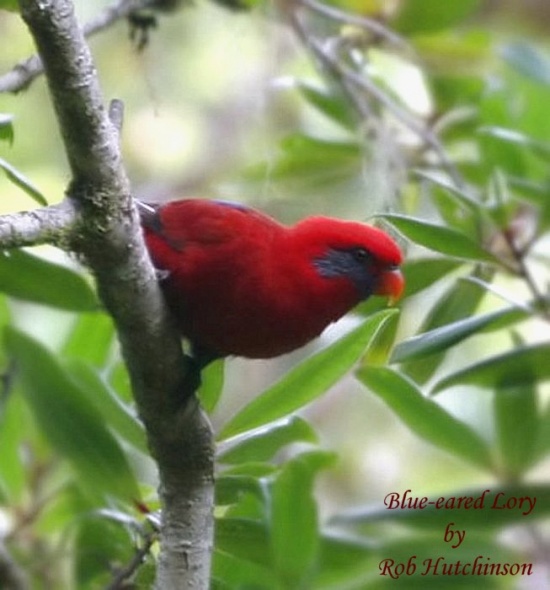
Blue-eared Lory
[order] PSITTACIFORMES | [family] Psittacidae | [latin] Eos semilarvata | [authority] Bonaparte, 1850 | [UK] Blue-eared Lory | [FR] Lori masque | [DE] Halbmasken-Lori | [ES] Lori de Seram | [NL] Blauwoorlori | [copyright picture] Rob Hutchinson
Subspecies
| Genus | Species | subspecies | Region | Range |
| Pseudeos | semilarvata | |||
| Eos | semilarvata | AU | Moluccas |
Genus
The genus Eos extends over the Moluccas and Western Papuan Islands, but does not occur anywhere near Borneo. Possibly the bird occurred on one of the Moluccas; there are a number of islands within the range of the genus where no representative species actually occurs. Very little is known about the ecology of lories of the genus Eos. All six species in the genus are endemic to Indonesia and most have very restricted ranges. They apparently need large trees to breed successfully. Four of the species, including the Black-winged Lory E. cyanogenia, have been traded in relatively large numbers during the last decade.
Physical charateristics
Both adults in general dark red; purple/blue on upper cheeks to ear coverts; purple/blue band down sides of neck; black primary feathers with wide red speculum; secondary feathers red with black tips; black tertials, washed with blue; red/brown tail. Eye orange/red.
| wingspan min.: | 0 | cm | wingspan max.: | 0 | cm |
| size min.: | 24 | cm | size max.: | 26 | cm |
| incubation min.: | 0 | days | incubation max.: | 0 | days |
| fledging min.: | 0 | days | fledging max.: | 0 | days |
| broods: | 0 | eggs min.: | 0 | ||
| eggs max.: | 0 |
Range
Australasia :Moutains of Seram, Moluccas
Habitat
Found generally above 1200m (3936 ft), but as low as 800m (2624 ft). Occurs in primary montane forest and upper montane heathlands up to mountain summit.
Reproduction
No data, the breeding season might be August.
Feeding habits
It feeds on flowering trees, including tree-heathers above the tree-line. The flocks are small.
Video Blue-eared Lory
httpv://www.youtube.com/watch?v=fLFT2Wzdg5c
copyright: Josep del Hoyo
Conservation
Although this species may have a restricted range, it is not believed to approach the thresholds for Vulnerable under the range size criterion (Extent of Occurrence <20,000 km2 combined with a declining or fluctuating range size, habitat extent/quality, or population size and a small number of locations or severe fragmentation). Despite the fact that the population trend appears to be decreasing, the decline is not believed to be sufficiently rapid to approach the thresholds for Vulnerable under the population trend criterion (>30% decline over ten years or three generations). The population size has not been quantified, but it is not believed to approach the thresholds for Vulnerable under the population size criterion (<10,000 mature individuals with a continuing decline estimated to be >10% in ten years or three generations, or with a specified population structure). For these reasons the species is evaluated as Least Concern.
Common in range despite its limited range.
Common in range despite its limited range.

Migration
Resident, probably w ith some altitudinal movements due to food availbility
Distribution map

